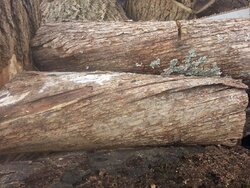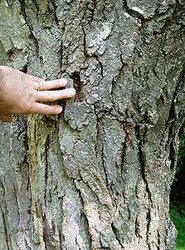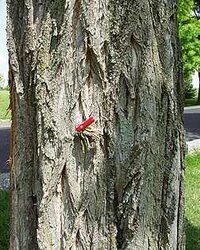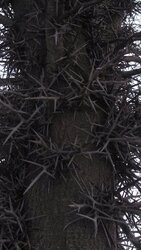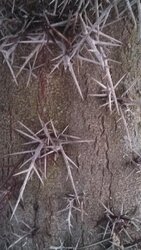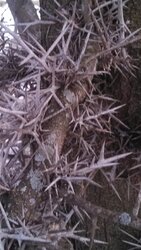Wood id please
- Thread starter hma
- Start date
-
Active since 1995, Hearth.com is THE place on the internet for free information and advice about wood stoves, pellet stoves and other energy saving equipment.
We strive to provide opinions, articles, discussions and history related to Hearth Products and in a more general sense, energy issues.
We promote the EFFICIENT, RESPONSIBLE, CLEAN and SAFE use of all fuels, whether renewable or fossil.
You are using an out of date browser. It may not display this or other websites correctly.
You should upgrade or use an alternative browser.
You should upgrade or use an alternative browser.
- Status
- Not open for further replies.
Ralphie Boy
Minister of Fire
Okay, I'll take a stab at it. The vertical tree/log on the left looks like black locust; the one on top running left to right (with the cut in it) looks like silver maple thats been down a while; the one under it could be from the same silver maple, but it's a bit hard to tell as it looks as though most of the bark is off. Of the 2 vertical logs on top; the one on the right kinda looks like black walnut bark and the one on the left... I won't venture to say as I can't see enough of it. So there's my best guess.  Now let's see what the pros from Dover have to say about it.
Now let's see what the pros from Dover have to say about it.
 Now let's see what the pros from Dover have to say about it.
Now let's see what the pros from Dover have to say about it.Okay, I'll take a stab at it. The vertical tree/log on the left looks like black locust; the one on top running left to right (with the cut in it) looks like silver maple thats been down a while; the one under it could be from the same silver maple, but it's a bit hard to tell as it looks as though most of the bark is off. Of the 2 vertical logs on top; the one on the right kinda looks like black walnut bark and the one on the left... I won't venture to say as I can't see enough of it. So there's my best guess.Now let's see what the pros from Dover have to say about it.
Sorry I meant the 2 horizontal ones. The others are honey locust. Thx
Applesister
Minister of Fire
Paulywalnut
Minister of Fire
very tough with no bark and unsplit. One on the bottom looks like what I remember elm looking like
before dutch elm disease.
before dutch elm disease.
rideau
Minister of Fire
Hophornbeam (Ironwood).
For some reason, they frequently grow really twisty...even in protected interior woods, so not a wind issue. I have some that spiral round and round. No fun to split. Fortunately (or unfortunately) most die before they are too big. I don't split them unless they are over about 8 inches. Let them stand dead, wait til they fall (years later), then cut them. The wood will still be fine. It can sit on the forest floor a few years and still be fine. Fabulous firewood. Let your trees grow as long as possible. Don't cut them live. Long dead trees, cut into rounds and stacked, burn beautifully after a year, but will keep many years if you have enough wood to save them. Burn them on long cold nights. Really special firewood. One big log will burn all night and put of lots of heat. Difference in heat output between Ironwood and Sugar Maple (and Beech) is very noticable.
For some reason, they frequently grow really twisty...even in protected interior woods, so not a wind issue. I have some that spiral round and round. No fun to split. Fortunately (or unfortunately) most die before they are too big. I don't split them unless they are over about 8 inches. Let them stand dead, wait til they fall (years later), then cut them. The wood will still be fine. It can sit on the forest floor a few years and still be fine. Fabulous firewood. Let your trees grow as long as possible. Don't cut them live. Long dead trees, cut into rounds and stacked, burn beautifully after a year, but will keep many years if you have enough wood to save them. Burn them on long cold nights. Really special firewood. One big log will burn all night and put of lots of heat. Difference in heat output between Ironwood and Sugar Maple (and Beech) is very noticable.
Ralphie Boy
Minister of Fire
aansorge
Minister of Fire
S
ScotO
Guest
Yeah that stuff laying horizontal looks like hophornbeam....but it also looks alot like the lilac I cut down at a job a while back. There was four HUGE shrubs, and I counted around 70-80 rings in the 'trunks' of those lilacs. Very, very dense wood, burned alot like locust........
HDRock
Minister of Fire
Applesister
Minister of Fire
I dont know how they get Honeylocust to genetically not produce thorns. But the natural growing variety here is full of thorns and usually poison ivy vines as well. And it gets that witches broom problem with multiple sprouts on its trunks. Nightmarish.
The horizontal wood also looks like cedar the way the bark slightly spirals.
The horizontal wood also looks like cedar the way the bark slightly spirals.
nrford
Minister of Fire
rideau
Minister of Fire
That is very, very typical Ironwood (hophornbeam) bark. It comes off in long stringy strips, and is very thin. If the round measures 8 inches, then it measures 8 inches with the bark off. . The wood often spirals as it grows. Often see lichen on the bark. Excellent firewood. Dense, durable wood. Makes great tool handles. Great for stacking wood on, if you happen to find dead young trees.(2-3 inch diameter). Bigger than that, use it for firewood. .
Hogwildz
Minister of Fire
Don't know the species, but that twist in it makes me think its going to be a big gnarly mess to split.
- Status
- Not open for further replies.
Similar threads
- Replies
- 0
- Views
- 283
- Replies
- 22
- Views
- 770


